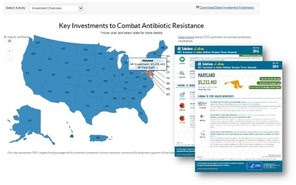
State-by-State Fact Sheets Show CDC's Work to Combat AR
A new tool shows CDC’s key investments to combat antibiotic resistance (AR) across the nation.
The CDC AR Investment Map includes an interactive web app and printable state- and city-specific fact sheets describing CDC’s work to tackle AR using fiscal year 2016 funds. These fact sheets can be used to better understand how CDC supports AR activities in your area.
View funding amounts by state and activity, including investments in:
- State and local public health partners to fight AR in healthcare facilities, the community, and food.
- Innovations and investigations to implement new ways to prevent antibiotic-resistant infections and contain their spread.
- Public health laboratories to boost state and local testing capacity and technology to detect and contain, support response to, and prevent AR threats nationwide.

With these investments, CDC, in partnership with health departments, academia, and healthcare, is transforming how the nation combats and slows antibiotic resistance at all levels, ensuring our ability to stand up a full, faster response to protect Americans from this threat.
CDC’s AR Solutions Initiative works toward meeting national goals outlined in the National Action Plan for Combatting Antibiotic Resistant Bacteria.
|
New Training to Improve Antibiotic Use in Animal Feed, Combat AR
New this year: All veterinarians, including accredited veterinarians, will need to use veterinary feed directives to direct the use of medicated feed by producers.
The National Veterinary Accreditation Program (NVAP) has announced a new training for veterinarians, titled Module 29 Veterinary Feed Directive. A veterinary feed directive (VFD, or VFD order) is issued by a licensed veterinarian to authorize a client to obtain and use animal feed containing antibiotics that are medically important to treat humans.

Improving Antibiotic Use in Food Animals to Combat AR
This training comes as new policies about antibiotic use in food animals went into effect on January 1, 2017. Under a Food and Drug Administration (FDA) guidance to address antibiotic resistance, antibiotics that have been designated medically important to humans can no longer be given to healthy animals to speed their growth. Antibiotic producers agreed to change labels on affected products to remove indications for use related to growth promotion, and to bring the remaining therapeutic uses of these products under the oversight of a veterinarian by the end of December 2016. Affected antibiotics that are administered through drinking water will change status from over-the-counter to prescription, and antibiotics administered through medicated feed will require a VFD.
Learn More About:
|
2017 Consumer Food Safety Education Conference

CDC experts will talk about food poisoning, risk perception, and how CDC is improving food safety at the 2017 Consumer Food Safety Education Conference later this month in Washington, D.C. CDC also will share education materials at an exhibit near the registration desk during the conference.
CDC speakers and topics are:
- Dr. Robert Tauxe, director of the Division of Foodborne, Waterborne, and Environmental Diseases, on CDC’s work to help consumers make good choices about food safety. 8:30 a.m. January 27
- Christine Prue, PhD, associate director for behavioral science for CDC’s National Center for Emerging and Zoonotic Infectious Diseases, on risk perception. 3:15 p.m. January 26
- Dr. Karen Neil, a medical epidemiologist in the Division of Foodborne, Waterborne, and Environmental Diseases, in a preconference workshop on raw dough and flour-related outbreaks. 1 p.m. January 25
The conference is hosted by the nonprofit Partnership for Food Safety Education. For more information or to register: http://cfsec2017.fightbac.org
New Infographic: Game Day Food Safety Tips

Planning on tackling a buffet at your next game-day party? Check out CDC's tips to make sure the food you serve is prepared and handled safely. Your starting lineup to avoid food poisoning:
Get the details from the infographic, and download a copy from our Food Safety website. While you're there, check out CDC's winter-themed food safety social media graphics and share on your accounts.
|
Article: E.coli O157 Infections and Pork
A recent article in CDC’s Morbidity and Mortality Weekly Report highlighted pork as a potential source for E. coli O157 infections by describing a 2014 outbreak in Alberta, Canada. This outbreak represents the second largest foodborne and third-largest overall E. coli O157 outbreak in Canadian history. Evidence indicates that the cause of this outbreak was exposure to contaminated pork products produced and distributed in Alberta. Pork should be considered a potential source in public health E. coli O157 investigations and prevention messaging. Pork handling and cooking practices should be carefully assessed during regulatory food facility inspections.
MMWR: Botulism Outbreak Associated with Drinking Prison-made Illicit Alcohol
A recent Notes from the Field in CDC’s Morbidity and Mortality Weekly Report described an outbreak of 31 inmates who got botulism after drinking an illicitly made alcoholic beverage known as “hooch” or “pruno.” This botulism outbreak is the largest in the United States since 1978 and highlights the clinical spectrum of illness. Educating correctional facility staff members and inmates about the risks of consuming hooch and good communication channels can help to identify and treat people with botulism quickly and prevent deaths.


































No hay comentarios:
Publicar un comentario